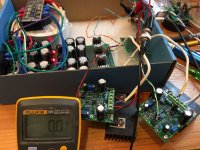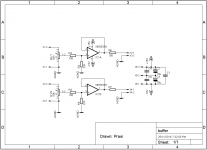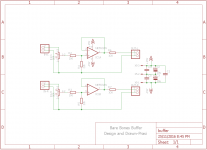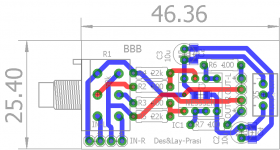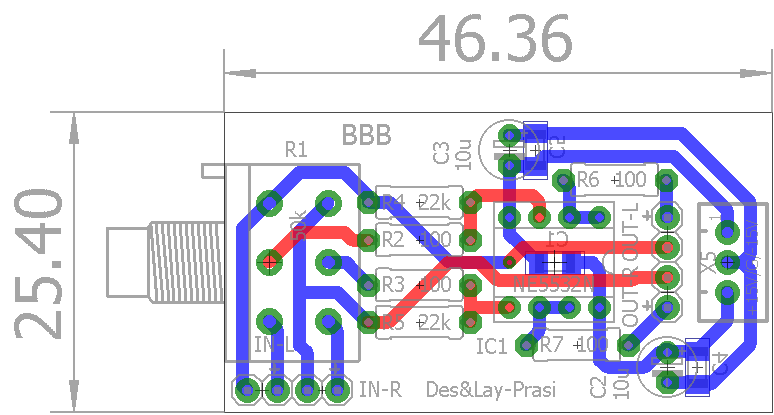beg to differ, if i understand Juma's post, he said, a simple 10k vol pot is ok...workable. its the x-feed ckt thats causing all the 'grief' (to use James Hadley's words as he used in his novels)...I have J310 and SK170 so B1 approach is good as it is simple and Transparent.
So the advantage of the F5HA is that it has FET inputs which allows passive volume to be used as if it had a buffer. So simpler circuit by 4 actives now if a B1buffer were to be added. Although the character of this current feedback amp is different than F5.
Works well now
I changed R2 and R3 to 47R now (33R was too small and did not have enough bias). With 47R max bias current is about 110mA so if you need more maybe 57R or so would be better. DC offset is very stable within 3mV. I got rid of the cross feed filter and am using a twin 50k pot wired between the input RCA jack and the PCB. The PCB is using 100k at R5 and I am running 100mA bias current (1.00v across R13).
The volume is now very good - formidable level and too loud at the max level when driven by my iPhone when using my Sony MDRV6 cans.
Noise performance is excellent, with no input, the headphone jack out measures 0.0mV AC with my Fluke 101. Cannot hear any background noise at all. However, when turning the volume knob, I can hear scratchy sound - not terrible. I soldered an earth ground from IEC socket to the shell of the pot and this got rid of the slight buzz/hum that was present at mid-volume.
I have spent about an hour now listening to various tracks. I really like the sound. Very clear and very transparent. No signature of its own - just good music that comes through as it should. One of my favorite test tracks is Nils Lofgren's "Keith Don't Go" - shows excellent articulation of transients and highs with acoustic guitar. Stand up bass from jazz trios are excellent: very clear and articulate. Piano is crisp and undistorted.
This head amp is a winner! Works fine with a 7815/7915 fed with a CRCLC supply.
I can't do an A/B test but I think I can hear the qualitative difference between a JFET front end and a BJT front end. They are both good, just different.
Here is a photo of the output noise test with 0.0mV AC.

So my recommended changes are:
1. Use R16=R18=R20=330R or a single 1k from R16 to R20 diagonally
2. Use 47R to 57R for R2 and R3 to get the correct bias range
3. Use R5=100k in conjunction with 50k pot for volume control
A very nice sounding headamp that can drive my 60ohm headphones very nicely.
I imagine that with the Nazar regulator and cap multiplier, the performance may be even better.
Thanks to Juma and Prasi for this fine amp. I guess it needs a box now. 🙂
I changed R2 and R3 to 47R now (33R was too small and did not have enough bias). With 47R max bias current is about 110mA so if you need more maybe 57R or so would be better. DC offset is very stable within 3mV. I got rid of the cross feed filter and am using a twin 50k pot wired between the input RCA jack and the PCB. The PCB is using 100k at R5 and I am running 100mA bias current (1.00v across R13).
The volume is now very good - formidable level and too loud at the max level when driven by my iPhone when using my Sony MDRV6 cans.
Noise performance is excellent, with no input, the headphone jack out measures 0.0mV AC with my Fluke 101. Cannot hear any background noise at all. However, when turning the volume knob, I can hear scratchy sound - not terrible. I soldered an earth ground from IEC socket to the shell of the pot and this got rid of the slight buzz/hum that was present at mid-volume.
I have spent about an hour now listening to various tracks. I really like the sound. Very clear and very transparent. No signature of its own - just good music that comes through as it should. One of my favorite test tracks is Nils Lofgren's "Keith Don't Go" - shows excellent articulation of transients and highs with acoustic guitar. Stand up bass from jazz trios are excellent: very clear and articulate. Piano is crisp and undistorted.
This head amp is a winner! Works fine with a 7815/7915 fed with a CRCLC supply.
I can't do an A/B test but I think I can hear the qualitative difference between a JFET front end and a BJT front end. They are both good, just different.
Here is a photo of the output noise test with 0.0mV AC.

So my recommended changes are:
1. Use R16=R18=R20=330R or a single 1k from R16 to R20 diagonally
2. Use 47R to 57R for R2 and R3 to get the correct bias range
3. Use R5=100k in conjunction with 50k pot for volume control
A very nice sounding headamp that can drive my 60ohm headphones very nicely.
I imagine that with the Nazar regulator and cap multiplier, the performance may be even better.
Thanks to Juma and Prasi for this fine amp. I guess it needs a box now. 🙂
Attachments
Last edited:
wow! thanks X, really nice work and trouble shooting/tryouts. glad you like it.
this HA with Nazar PSU would be something i guess. have you ordered PCB's for the Nazar PSU?
that scratchy sound would be from pot, my guess... Try "dipping in IPA and vigorous rotation routine"...
or use a stepped pot. I have had bad experiences with pots, now i use step pot on my main integrated amp.
reg
Prasi
edit.
i am thinking to use a 1 uf cap at i/p. or people prefer DC coupled.. what say?
this HA with Nazar PSU would be something i guess. have you ordered PCB's for the Nazar PSU?
that scratchy sound would be from pot, my guess... Try "dipping in IPA and vigorous rotation routine"...
or use a stepped pot. I have had bad experiences with pots, now i use step pot on my main integrated amp.
reg
Prasi
edit.
i am thinking to use a 1 uf cap at i/p. or people prefer DC coupled.. what say?
Last edited:
Just to make some things clear:
- 50k volume pot is a bad idea. It puts max. resistance of 12k5 in series with the input, so 10k volume pot is a much better choice.
- Use R5=100k only if you want to use coupling cap. R5=100k enables use of a small coupling cap (1uF) so you can have a good quality cap at the input without having to pay too much for it. High value of R5 will (together with using Vbe/hfe unmatched BJTs) cause input DC offset that will manifest as scratching sound when turning the volume pot.
If you are not going to use coupling cap make R5=22k or lower (even 10k is OK).
So, the value of R5 will depend on how good are your BJTs matched. They are cheap and abundant so it's not a big deal.
There is an easy and cheap, but very good way to match your small signal components by curve-tracing them on the PC screen:
Peak Electronic Design Limited - Atlas DCA Pro - Advanced Semiconductor Analyser - Model DCA75
- Usual hygiene measure apply here too: heatsinks and the pot housing need grounding etc...
- 50k volume pot is a bad idea. It puts max. resistance of 12k5 in series with the input, so 10k volume pot is a much better choice.
- Use R5=100k only if you want to use coupling cap. R5=100k enables use of a small coupling cap (1uF) so you can have a good quality cap at the input without having to pay too much for it. High value of R5 will (together with using Vbe/hfe unmatched BJTs) cause input DC offset that will manifest as scratching sound when turning the volume pot.
If you are not going to use coupling cap make R5=22k or lower (even 10k is OK).
So, the value of R5 will depend on how good are your BJTs matched. They are cheap and abundant so it's not a big deal.
There is an easy and cheap, but very good way to match your small signal components by curve-tracing them on the PC screen:
Peak Electronic Design Limited - Atlas DCA Pro - Advanced Semiconductor Analyser - Model DCA75
- Usual hygiene measure apply here too: heatsinks and the pot housing need grounding etc...
the "Hi," adds time to my posts.
But it's still implied:
I start with a lower case letter because it follows after the comma of the "Hi,"
But it's still implied:
I start with a lower case letter because it follows after the comma of the "Hi,"
Get some 10k pots. IMO 50k is too much for serious audio - it will either make a strong low pass filter with FET's parasitic capacitance or modulate the base of BJT.... Since 50k pots are all I have at present, what should I do?
These days it's very hard to find stereo pots with matched channels so few years ago I bought a certain quantity of good 4 x 24-position switches which I turn into attenuators and that works much better than black/blue Alps pots (which usually have 3-6 dB difference between channels, especially at low volume setting)
how about using this? 'no frills', bare-to-bones buffer
reg
prasi
assumption is ha will have 1u i/p coupling cap.
C1 will be across pin 4 and 8..
reg
prasi
assumption is ha will have 1u i/p coupling cap.
C1 will be across pin 4 and 8..
Attachments
Last edited:
instead of using the Agnd symbols, just join the wires together.how about using this? 'no frills', bare-to-bones buffer
reg
prasi
assumption is ha will have 1u i/p coupling cap.
C1 will be across pin 4 and 8..
Then the sch shows the propective Builder what needs to be connected and helps avoid many of the grounding errors that so many make - repeatedly.
how about using this? 'no frills', bare-to-bones buffer
reg
prasi
assumption is ha will have 1u i/p coupling cap.
C1 will be across pin 4 and 8..
Oh no.... op amps heaven forbid. 🙂
I think four JFETs like a B1 would sound better. Juma says a J310 can work fine and save your SK170's.
Then why bother with discrete headamp at all ? Just use AD8397 or similar - it won't be worse than NE5532...how about using this?...
Bare Bones Buffer-just an idea, expert views are welcomeinstead of using the Agnd symbols, just join the wires together.
Then the sch shows the propective Builder what needs to be connected and helps avoid many of the grounding errors that so many make - repeatedly.
Attachments
Last edited:
SKA sponsored Audio Forum - ProductsOh no.... op amps heaven forbid. 🙂
I think four JFETs like a B1 would sound better. Juma says a J310 can work fine and save your SK170's.
Whatever we use for the buffer, it will allow the cross feed filter to be used. I think the sound of the head amp with cross feed sounds better and less like your head is between two headphones. Apex has a nice preamp with 6 x BC550/560's.
Some people tend to want more and more..my daughter is like that..LOL
BTW, not everyone like Crossfeed, I dislike them, IMHO they blur the sound.
I believe the 2 mono Juma HA (with added input cap) + a single Nazar CM would be great.
My 2 cents..
Eric
BTW, not everyone like Crossfeed, I dislike them, IMHO they blur the sound.
I believe the 2 mono Juma HA (with added input cap) + a single Nazar CM would be great.
My 2 cents..
Eric
That's much better. It shows what must be connected.Bare Bones Buffer-just an idea, expert views are welcome
It also shows that nothing else gets connected, there's not a "ground" in sight !
And probably most importantly it shows the loops in the wiring and allows you to adjust those loops to minimise loop area.
- Home
- Amplifiers
- Pass Labs
- Juma's Head Amp
